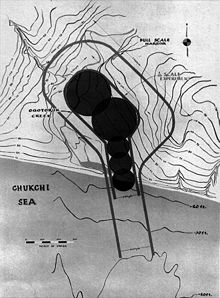Operation Chariot (1958)
Operation Chariot was planned by the United States Atomic Energy Commission (AEC) in 1958 to create an artificial seaport in Cape Thompson , Alaska 42 km southeast of the town of Point Hope by detonating a series of hydrogen bombs . Initially the plan envisaged a chain explosion with 2.4 megatons , then only 460 and ultimately only 280 kilotons .
The plan emerged in the context of Operation Plowshare ("Operation Ploughshare"), in the framework of which an attempt was made to find civilian applications for nuclear explosions. The plan was pursued by many interest groups: A key supporter was the Hungarian-American physicist Edward Teller , who was known as the "father of the hydrogen bomb".
In 1958, Teller was on a PR tour through Alaska on behalf of the AEC to convince the local population of the economic sense and purpose of an ocean port north of the Arctic Circle and the civil use of nuclear explosives. He announced several times that he could use atomic bombs to blow up a hole in the shape of a polar bear.
This plan was only stopped - or more precisely "paused" by the AEC in 1962 under the Kennedy administration . The reasons for this were the massive protest of the local, mostly indigenous population in Point Hope, Noatak and Kivalina , as well as a small group of oppositional contract scientists from the AEC, which was supposed to carry out geological and biological preliminary investigations on site. They received support from well-known organizations such as the Sierra Club or Berry Commoners Greater St. Louis Citizens' Committee for Nuclear Information (CNI) were active and well networked throughout the USA.
The fact that the planned port was not needed only played a subordinate role in the decision to "pause": As early as 1958, economists from Alaska told Edward Teller and other AEC specialists that the port at Cape Thompson was not economically viable because it was around three quarters of the year completely iced over and therefore unusable. Since then, the AEC has only understood and marketed the Chariot Plan as a “civil” “ crater experiment” with no economic meaning. The risks that the thermonuclear explosions would pose to local residents were never officially recognized as the reason for the end of Operation Chariot. Rather, it was declared superfluous because the hoped-for scientific data could already be determined by other "civil" nuclear tests, such as the Sedan test . The project was never officially abandoned.
See also
literature
- Dan O'Neill: The Firecracker Boys . St. Martin's Press, New York NY 1994, ISBN 0-312-11086-3 .
- Norman Chance: Project Chariot: The Nuclear Legacy of Cape Thompson, Alaska .
- Robert Bache: Project Chariot - fight for "civil" H bombs in the Arctic Circle 1957–1962 . Bielefeld 2014 ( PDF ).
Individual evidence
- ^ Robert Bache: Project Chariot - fight for "civil" H-bombs in the Arctic Circle 1957-1962 . Bielefeld 2014, p. 71 .
- ^ Dan O'Neill: Project Chariot: How Alaska Escaped Nuclear Excavation . In: Bulletin of the Atomic Scientists . tape 45 , no. 10 , 1989 ( online [accessed January 26, 2013]).
- ^ Robert Bache: Project Chariot - fight for "civil" H-bombs in the Arctic Circle 1957-1962 . Bielefeld 2014, p. 46-50 .
- ^ Robert Bache: Project Chariot - fight for "civil" H-bombs in the Arctic Circle 1957-1962 . Bielefeld 2014, p. 55-71 .
- ^ Robert Bache: Project Chariot - fight for "civil" H-bombs in the Arctic Circle 1957-1962 . Bielefeld 2014, p. 79-81 .
Coordinates: 68 ° 6 ′ 7 ″ N , 165 ° 45 ′ 19 ″ W.
